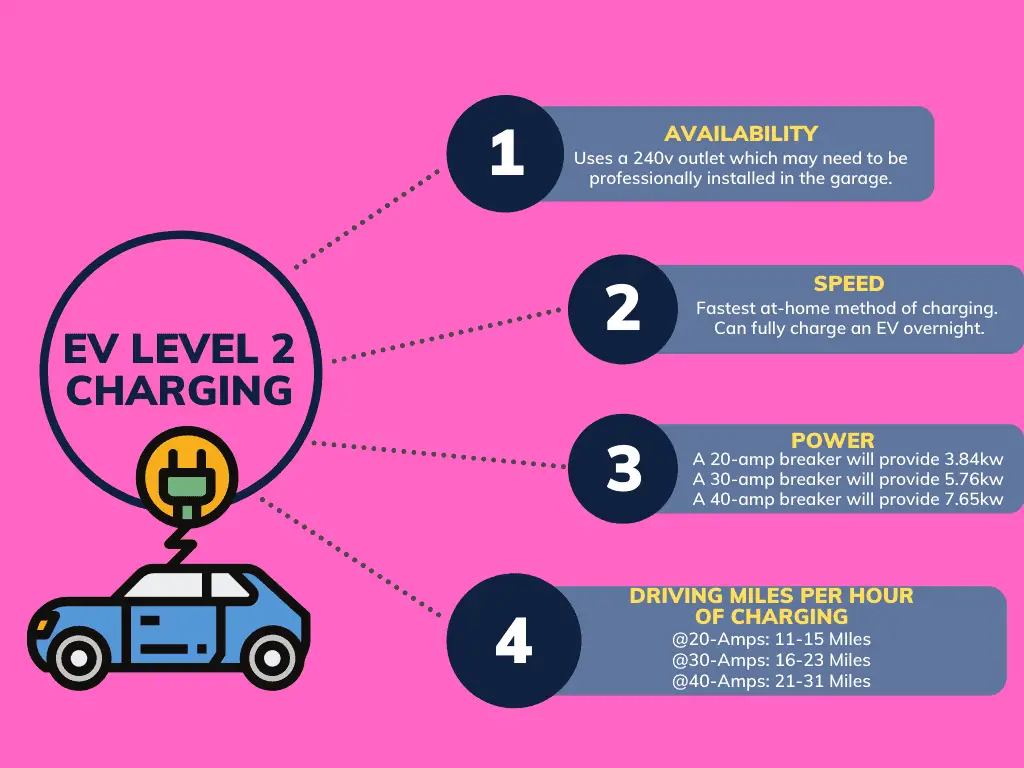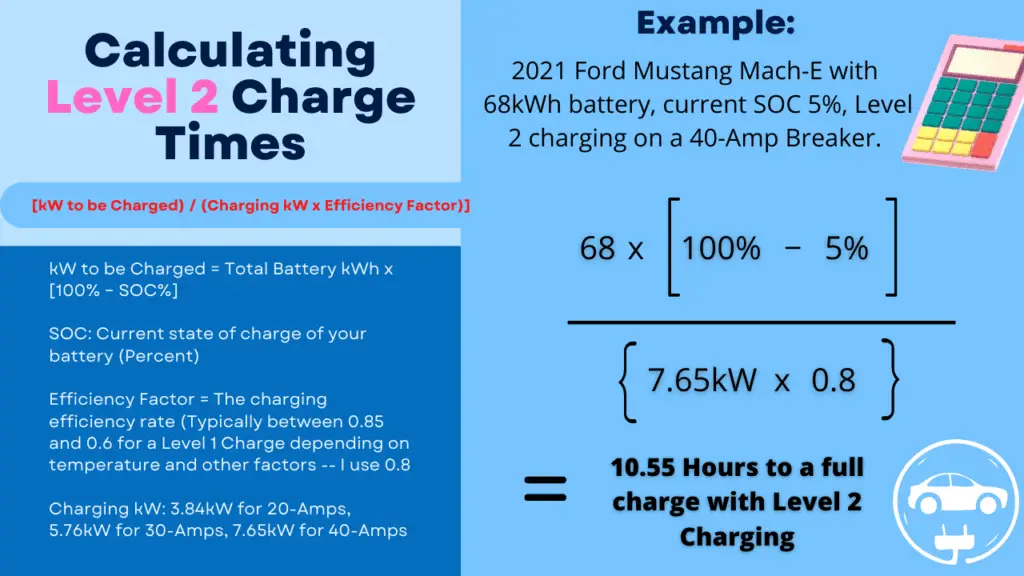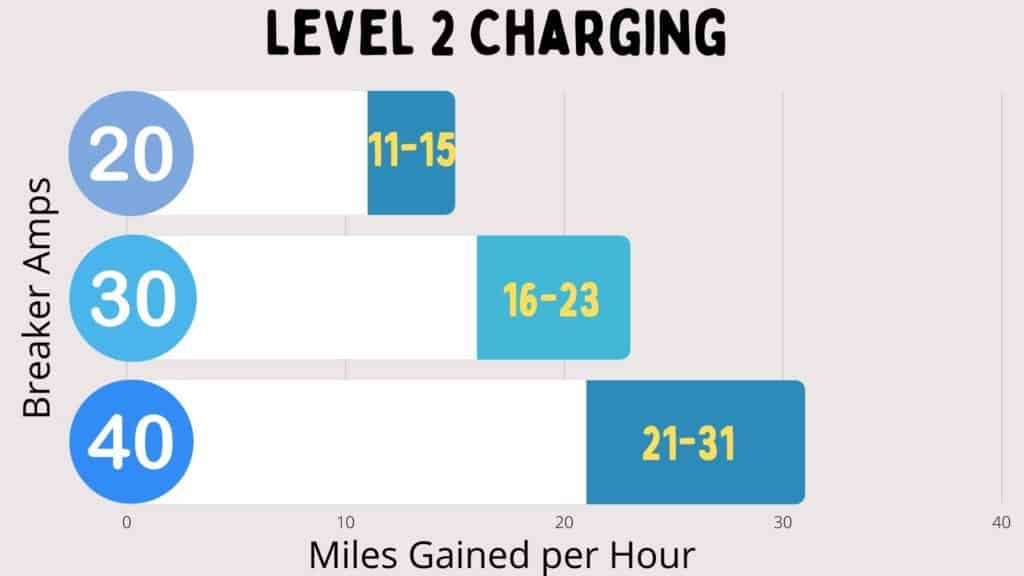Many electric vehicles (EV) that you purchase today will include a Level 2 EVSE (electric vehicle supply equipment). It’s definitely a step up from the turtle speed of Level 1 charging, but just how much faster is Level 2 charging?
An average EV will gain about 15-40 miles per hour of Level 2 charging and will fully charge from empty overnight. Level 2 charging is the fastest at-home EV charging method and is done at 240 volts of alternating current. Generally, a dedicated 30 or 40-amp breaker is used for Level 2 charging.
In this brief article, we’ll take a look at how the top 11 best selling EV models stack up against each other when it comes to level 2 charging, and how to quickly calculate these numbers yourself for any electric vehicle.
If you’re interested in how long it would take to charge an EV at Level 1 and Level 3 charging, you can check out my other article here.
How Fast is Level 2 EV Charging?
Level 2 charging at 240-volts will charge at a speed of 3.85kW with a 20-amp breaker, 5.76kW with a 30-amp breaker, and 7.65kW with a 40-amp breaker. These speeds will fully charge an average electric vehicle overnight and generally replenish about 11-31 driving miles per hour of charging with the aforementioned breakers.
Level 2 charging uses a 240-volt outlet that you would typically use for an electric dryer or an electric range. 240-volts is twice the amount of pressure behind the amps as you’d find in a typical 120-volt household outlet.
If you trace the wires from your outlet back through the walls, they’ll all converge at your main breaker box. Inside that box you’ll generally see that the 240-volt breakers are either 15, 20, 30, or 40-amps in size.

A 15 or 20-amp breaker might be used for a well pump, a 30-amp might be used for the AC and an electric dryer, and the 40-amp might be used for the electric stove and range.
It is highly recommended that you have a dedicated breaker for your EV when charging, which means that you won’t be powering anything else except your EV from that breaker.
Any breaker will have rated running amps of 80% of the number on the breaker itself. So, a 20-amp breaker will actually operate at 16 amps, and a 40-amp breaker at 32. It can go a little higher for short periods before tripping, but it doesn’t want to exceed 80%.
Below we can see how many kilowatts are streamed through each of the outlets based on their breaker size:
- 20-amp Breaker: 240-volts x 16-amps = 3.84kw
- 30-amp Breaker: 240-volts x 24-amps = 5.76kw
- 40-amp Breaker: 240-volts x 32-amps = 7.65kw
An important thing to keep in mind is that when using 120 or 240-volts of electricity, the charger is actually located inside the car — you’re just providing power to it via the EVSE. The internal charger of every make and model will have a limit to how much electricity it can accept.
Most makes and models can fully accept a Level 2 charge from a 40-amp breaker. You can have an electrician upgrade your main panel to supply higher amperages, but your EV might not be able to accept it if you did and the upgrade would be a waste of money.
For instance, as you’ll see in the table in the next section, a 2021 Nissan Leaf has a small battery capacity to begin with (37kWh) and maxes out at 6.6kW for Level 2 charging. It cannot even fully accept the charge from a 40-amp breaker. Upgrading your panel to a higher breaker would be pointless.
How Long Does it Take to Charge an EV with Level 2 Charging?
When determining how long it will take to charge an electric vehicle with Level 2 charging, you first need to figure out how many kWh (kilowatt hours) you need to replace in your EV’s battery.
Use the following steps to figure out how to determine the kWh to be charged:
- Step 1: Find the net battery capacity of your vehicle (or usable portion of the battery for propulsion) using this website
- Step 2: See what percentage your battery is at and subtract that number from 100
- Step 3: Multiply the number from Step 2 as a percentage (0.XX) by the total net battery capacity
- Step 4: Multiply the total kilowatts of your breaker (3.84 for a 20-amp breaker, or 5.76 for a 30-amp breaker, and 7.65 for a 40-amp breaker) by the charging efficiency factor (I generally use 0.8 to simulate average conditions, but you may want to drop as low as 0.6 if your car is in an unheated garage in the winter)
- Step 5: Divide the answer from Step 3 by the answer in Step 4

Example:
Let’s look at the Tesla Model Y on the top row of the table below. Let’s pretend that the battery is at 10% state of charge and the total Net Capacity is 75kWh. The breaker we’re using is a 40-amp breaker and we’ll roll with an 80% efficiency factor.
- 100% – 10% = 90% that needs to be recharged
- 0.90 x 75kWh = 67.5kWh to be recharged
- 67.5kWh / (7.65 x 0.8) = 11 Hours to charge
All of the calculations in the following table were done by calculating the charging time for replenishing 100% of the battery capacity and not a fraction of it.
This table shows the Level 2 charging times (in hours) with 20, 30, and 40-amp breakers for the top 11 selling EV models in the last year.
| EV Model | Year | Gross Battery Capacity (kWh) | Internal Level 2 Charging Limit in Kilowatts | Level 2 Charging Time (Hours) @20A from Empty | Level 2 Charging Time (Hours) @30A from Empty | Level 2 Charging Time (Hours) @40A from Empty |
|---|---|---|---|---|---|---|
| Tesla Model Y | 2020 | 75 | 11.5 | 24 | 16 | 12 |
| Tesla Model 3 | 2020 | 57.5 | 7.6 | 19 | 12 | 9 |
| Ford Mustang Mach E | 2021 | 68 | 10.5 | 22 | 15 | 11 |
| Chevy Bolt EV | 2021 | 60 | 7.2 | 20 | 13 | 10 |
| Volkswagen ID.4 | 2021 | 77 | 11 | 25 | 17 | 13 |
| Nisan Leaf | 2021 | 37 | 6.6 | 12 | 8 | 7 |
| Audi e-tron | 2021 | 86 | 9.6 | 28 | 19 | 14 |
| Porsche Taycan | 2021 | 71 | 9.6 | 23 | 15 | 12 |
| Tesla Model S | 2020 | 95 | 11.5 | 31 | 21 | 16 |
| Hyundai Kona Electric | 2021 | 64 | 7.2 | 21 | 14 | 10 |
| Tesla Model X | 2020 | 95 | 11.5 | 31 | 21 | 16 |
How Many Miles of Driving Range per Hour with Level 2 Charging?
On average, an electric vehicle will gain 11-31 miles of driving range per hour of Level 2 charging depending on whether a 20, 30, or 40-amp breaker is used. Larger breakers for faster charge times can be professionally installed. Level 2 charging provides 3.84-7.65kW of power per hour, and an average EV will get 3-5 miles of range per kilowatt hour.

| Level 2 Charging Breaker Size | Miles Gained Per Hour of Charge |
|---|---|
| 20 Amp | 11 – 15 |
| 30 Amp | 16 – 23 |
| 40 Amp | 21 – 31 |
You can calculate a solid ballpark estimate of the total miles of range gained per hour for your particular model, or any model that you’re interested in by following these steps:
- Step 1: Locate your EV’s EPA MPGe rating (miles per gallon equivalent) with this website and divide the MPGe by 33.7
- Step 2: Multiply your answer from Step 1 by either 3.84kW for a 20-amp breaker, or 5.76kW for a 30-amp breaker, or 7.65 for a 40-amp breaker
- Step 3: Multiply your answer from Step 2 by the charging efficiency factor (Again, I use 0.8, but you could use as low as 0.6 for really cold weather, or 0.9 great conditions)

Example:
A 2020 Tesla Model Y has an EPA combined MPGe of 111 (you can use city, or highway if that’s what your primary driving consists of), we’ll be charging with a 40-amp breaker, and our efficiency factor will be 0.8.
- 111 / 33.7 = 3.29 miles per kilowatt hour
- 3.29 x 7.65kW = 25.17 miles of range before inefficiencies
- 25.17 x 0.8 = 20.14 miles of range per hour of Level 1 charging at 20-amps
Below you can check out the top selling 11 models over the last year and how many miles they gain per hour of Level 1 charging with 20, 30, and 40 amps.
| EV Model | Year | Combined EPA MPGe | Miles Gained Per Hour with Level 2 Charging at 20A | Miles Gained Per Hour with Level 2 Charging at 30A | Miles Gained Per Hour with Level 2 Charging at 40A |
|---|---|---|---|---|---|
| Tesla Model Y | 2020 | 111 | 10.1 | 15.16 | 20.13 |
| Tesla Model 3 | 2020 | 131 | 11.92 | 17.88 | 23.74 |
| Ford Mustang Mach E | 2021 | 93 | 8.48 | 12.72 | 16.89 |
| Chevy Bolt EV | 2021 | 118 | 10.75 | 16.13 | 21.42 |
| Volkswagen ID.4 | 2021 | 97 | 8.82 | 13.22 | 17.56 |
| Nissan Leaf | 2021 | 111 | 10.1 | 15.16 | 20.13 |
| Audi e-tron | 2021 | 78 | 7.1 | 10.64 | 14.14 |
| Porsche Taycan | 2021 | 79 | 7.19 | 10.74 | 14.32 |
| Tesla Model S | 2020 | 109 | 9.92 | 14.88 | 19.77 |
| Hyundai Kona Electric | 2021 | 120 | 10.94 | 16.4 | 21.79 |
| Tesla Model X | 2020 | 90 | 8.2 | 12.3 | 16.34 |

